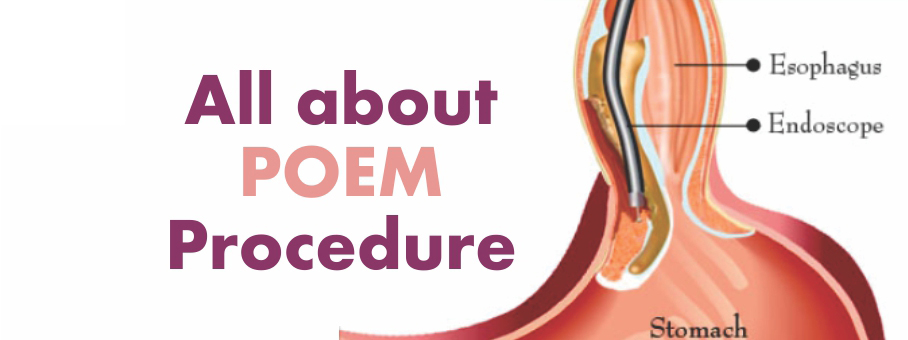POEM : An advanced endoscopic procedure to treat Achalasia cardia

An advanced endoscopic procedure, Peroral Endoscopic Myotomy (POEM) is recommended to treat swallowing disorders such as Achalasia. This is an in-patient procedure that takes a minimum of one to three hours to complete the procedure. Patients usually require about two to three days of hospital stay. Achalasia is a rare disorder in which the esophagus muscles and the lower sphincter lose the ability to relax and it becomes quite difficult to swallow and pass the food into the stomach leading to difficulty in swallowing. Apart from swallowing related issues, the other symptoms that are experienced by the patient suffering from the disease are weight loss and heartburn. Achalasia also carries a potential risk of cancer in the long term.
SR Kalla Hospital as one of the premier multispecialty hospitals has diagnosed more than 300 Achalasia Cardia cases and successfully performed more than 100 POEM procedures in the last 3 years. All the patients are healthy and more than 200 patients are on regular follow-up. The results and outcomes of POEM are comparable to previously proposed treatments and superior in terms of patient comfort and shorter hospital stay. POEM is highly preferred for treating Achalasia.
About the procedure :
Esophageal Manometry is done to diagnose and assess baseline values for dysphagia before the procedure
A Pre anaesthetic clearance checkup is done to ensure the patient's general condition and fitness for the procedure.
Procedure is carried out under General Anesthesia and is thus completely painless.
Mucosal Incision
The longitudinal incision is made with careful dissection of the submucosal fibers near the linear incision that allows the endoscope to be introduced into the submucosal space. Longitudinal incision assists in better closure of the endoscopic clips as compared to the horizontal incision that results in the suturing of the incision.
Creating a submucosal tunnel
The endoscope is advanced within the submucosa by the incision made while preserving the integrity of the mucosa. The preservation is of utmost importance as it is the only barrier that exists between the mediastinum and esophageal lumen after the myotomy. Hemostatic forceps are used to coagulate the larger blood vessels present in the submucosa. Identification of the GastroEsophageal Junction (GEJ) is done by observing and visualizing the longitudinal muscle bundle present at the GEJ which narrows the submucosal space and restricts the advancement of the endoscope through GEJ.
Myotomy
The clinical outcomes and the short-term relief of both types of procedures can be effectively compared. Full-thickness myotomy takes significantly less time which reduces the overall time of the POEM procedure whereas the other methods are time-consuming. Moreover, with myotomy, adverse events like reflux can be reduced.
Closure of the mucosal incision
This is the last stage that involves careful inspection of the submucosal tunnel for successful closure of the mucosal incision post myotomy. The endoscopic suturing devices or endoscopic clips are used to close the incision site. The endoscopist performing the procedure should take all necessary precautions to avoid chances of active bleeding before closing the incision.
Post-operative care is another important aspect associated with the POEM procedure and the studies have shown the intervention has a high success rate in managing the symptoms of Achalasia. When compared with other procedures such as Laparoscopic Heller's Myotomy, and Endoscopic Balloon dilation, POEM shows comparable results with shorter hospital stay and enhanced patient comfort. Successful POEM is able to avoid a major abdominal surgery.
Do not ignore difficulty in swallowing and Discuss treatment options for achalasia today.